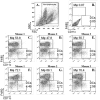CXCL17 is a major chemotactic factor for lung macrophages
- PMID: 24973458
- PMCID: PMC4142799
- DOI: 10.4049/jimmunol.1400551
CXCL17 is a major chemotactic factor for lung macrophages
Abstract
Chemokines are a superfamily of chemotactic cytokines that direct the movement of cells throughout the body under homeostatic and inflammatory conditions. The mucosal chemokine CXCL17 was the last ligand of this superfamily to be characterized. Several recent studies have provided greater insight into the basic biology of this chemokine and have implicated CXCL17 in several human diseases. We sought to better characterize CXCL17's activity in vivo. To this end, we analyzed its chemoattractant properties in vivo and characterized a Cxcl17 (-/-) mouse. This mouse has a significantly reduced number of macrophages in its lungs compared with wild-type mice. In addition, we observed a concurrent increase in a new population of macrophage-like cells that are F4/80(+)CDllc(mid). These results indicate that CXCL17 is a novel macrophage chemoattractant that operates in mucosal tissues. Given the importance of macrophages in inflammation, these observations strongly suggest that CXCL17 is a major regulator of mucosal inflammatory responses.
Copyright © 2014 by The American Association of Immunologists, Inc.
Figures





Similar articles
-
A comprehensive review of chemokine CXC17 (VCC1) in cancer, infection, and inflammation.Cell Biol Int. 2022 Oct;46(10):1557-1570. doi: 10.1002/cbin.11846. Epub 2022 Jul 10. Cell Biol Int. 2022. PMID: 35811438 Review.
-
CCL7 and CXCL10 orchestrate oxidative stress-induced neutrophilic lung inflammation.J Immunol. 2002 Jan 15;168(2):846-52. doi: 10.4049/jimmunol.168.2.846. J Immunol. 2002. PMID: 11777981
-
Cutting edge: GPR35/CXCR8 is the receptor of the mucosal chemokine CXCL17.J Immunol. 2015 Jan 1;194(1):29-33. doi: 10.4049/jimmunol.1401704. Epub 2014 Nov 19. J Immunol. 2015. PMID: 25411203 Free PMC article.
-
CXCL17 is a mucosal chemokine elevated in idiopathic pulmonary fibrosis that exhibits broad antimicrobial activity.J Immunol. 2012 Jun 15;188(12):6399-406. doi: 10.4049/jimmunol.1102903. Epub 2012 May 18. J Immunol. 2012. PMID: 22611239 Free PMC article.
-
What defines a chemokine? - The curious case of CXCL17.Cytokine. 2023 Aug;168:156224. doi: 10.1016/j.cyto.2023.156224. Epub 2023 May 19. Cytokine. 2023. PMID: 37210967 Review.
Cited by
-
CXCL17 Is a Specific Diagnostic Biomarker for Severe Pandemic Influenza A(H1N1) That Predicts Poor Clinical Outcome.Front Immunol. 2021 Feb 26;12:633297. doi: 10.3389/fimmu.2021.633297. eCollection 2021. Front Immunol. 2021. PMID: 33717172 Free PMC article.
-
Tumor cell expression of B7-H4 correlates with higher frequencies of tumor-infiltrating APCs and higher CXCL17 expression in human epithelial ovarian cancer.Oncoimmunology. 2019 Sep 30;8(12):e1665460. doi: 10.1080/2162402X.2019.1665460. eCollection 2019. Oncoimmunology. 2019. PMID: 31741762 Free PMC article.
-
Changes of tumor microenvironment in non-small cell lung cancer after TKI treatments.Front Immunol. 2023 Mar 6;14:1094764. doi: 10.3389/fimmu.2023.1094764. eCollection 2023. Front Immunol. 2023. PMID: 36949948 Free PMC article. Review.
-
CXCL17 is an allosteric inhibitor of CXCR4 through a mechanism of action involving glycosaminoglycans.Sci Signal. 2024 Mar 19;17(828):eabl3758. doi: 10.1126/scisignal.abl3758. Epub 2024 Mar 19. Sci Signal. 2024. PMID: 38502733 Free PMC article.
-
The protective and pathogenic roles of CXCL17 in human health and disease: Potential in respiratory medicine.Cytokine Growth Factor Rev. 2020 Jun;53:53-62. doi: 10.1016/j.cytogfr.2020.04.004. Epub 2020 Apr 23. Cytokine Growth Factor Rev. 2020. PMID: 32345516 Free PMC article. Review.
References
-
- Bachelerie F, Ben-Baruch A, Burkhardt AM, Combadiere C, Farber JM, Graham GJ, Horuk R, Sparre-Ulrich AH, Locati M, Luster AD, Mantovani A, Matsushima K, Murphy PM, Nibbs R, Nomiyama H, Power CA, Proudfoot AE, Rosenkilde MM, Rot A, Sozzani S, Thelen M, Yoshie O, Zlotnik A. International Union of Pharmacology. LXXXIX. Update on the extended family of chemokine receptors and introducing a new nomenclature for atypical chemokine receptors. Pharmacological reviews. 2014;66:1–79. - PMC - PubMed
-
- Pisabarro MT, Leung B, Kwong M, Corpuz R, Frantz GD, Chiang N, Vandlen R, Diehl LJ, Skelton N, Kim HS, Eaton D, Schmidt KN. Cutting edge: novel human dendritic cell- and monocyte-attracting chemokine-like protein identified by fold recognition methods. J Immunol. 2006;176:2069–2073. - PubMed
-
- Weinstein EJ, Head R, Griggs DW, Sun D, Evans RJ, Swearingen ML, Westlin MM, Mazzarella R. VCC-1, a novel chemokine, promotes tumor growth. Biochemical and biophysical research communications. 2006;350:74–81. - PubMed
Publication types
MeSH terms
Substances
Grants and funding
LinkOut - more resources
Full Text Sources
Other Literature Sources
Molecular Biology Databases

